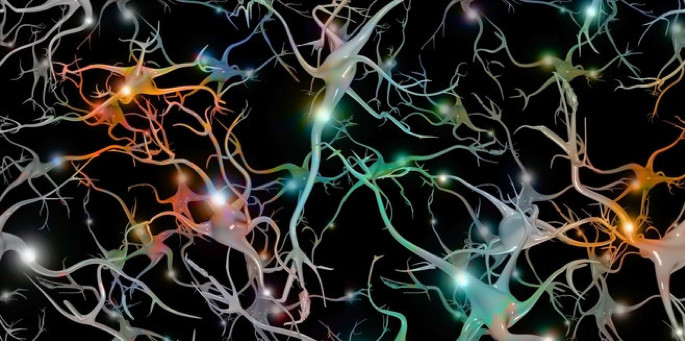如果你看过《头脑特工队》,一定会对里面忧忧印象深刻。总是感到难过伤心的忧忧负责生成、储存和调取悲伤的蓝色记忆球。那么悲伤在我们的大脑中究竟是什么样子的呢?
关键词:科普、译文、大脑、悲伤

Credit: Shutterstock
Feelings of sadness or anxiety might be linked to increased 'chitchat' between two areas of the brain, a new study suggests.
一项新的研究表明,悲伤或焦虑的感觉可能与大脑两个区域之间 '闲聊' 的增加有关。
In the study, published today (Nov. 8) in the journal Cell, a group of researchers listened in on electrical conversations in the brain - in other words, the signals that brain regions send to one another. When a person is feeling down, they found, the communication increased between brain cells in two specific regions of the brain involved in memory and emotion.
在今天(11月8日)发表在《细胞》杂志上的研究中,一组研究人员听取了大脑中的电子对话 - 换句话说,就是大脑各区域相互发送的信号。当一个人感到沮丧时,他们发现,大脑中负责记忆和情绪的两个特定区域的脑细胞之间的交流就会增加。
It's unclear whether this increased brain communication is a cause or an effect of a bad mood, the researchers noted. However, the findings allowed them to home in on the part of the brain where the action is.
研究人员指出,尚不清楚这种大脑交流的增加是心情不好的原因还是影响。然而,这些发现使他们能够回到大脑中的行动所在的位置。
What is clear, however, is that anxiety, depression and mood have physical manifestations in the brain. 'For many patients, it is very important to know that when they are feeling depressed, it is due to something measurable and concrete within their brain,' said co-senior study author Dr. Vikaas Sohal, a psychiatrist at the University of California, San Francisco. 'For some patients, this can provide important validation and remove stigma, empowering them to seek appropriate treatment.'
然而,显而易见的是,焦虑,抑郁和情绪在大脑中有生理表现。'对于许多患者来说,知道他们感到抑郁是由于他们大脑中某种可测量的、具体的东西引起的,这一点非常重要。'加州大学旧金山分校的精神病学家、共同资深研究作者Vikaas Sohal博士说。'对于一些患者来说,这可以提供重要的验证并消除耻辱感,使他们能够寻求适当的治疗。'
The researchers carried out the study using a technique called intracranial electroencephalography (EEG). As the word 'intracranial' implies, the method involves implanting electrodes or wires inside the skull - in and on the brain. These implanted electrodes record the electrical activity of brain cells (in other words, record their communication).
研究人员使用一种称为颅内脑电图(EEG)的技术进行了这项研究。正如'颅内'一词所暗示的那样,该方法涉及在颅骨内部植入电极或电线 - 在大脑内和大脑上。这些植入的电极记录了脑细胞的电活动(换句话说,记录它们的交流)。
Previous studies looking at brain activity and mood and emotion were mostly conducted using functional magnetic resonance imaging (fMRI), a type of imaging that measures changes in blood flow to different parts of the brain. But those 'are indirect measures of brain activity' and they 'cannot measure changes in brain activity that occur on very fast timescales,' like the ones measured in this study, Sohal said.
之前关于大脑活动,情绪和情感的研究大多是使用功能性磁共振成像(fMRI)进行的,这是一种测量到大脑不同部位血液流动变化的成像技术。但是那些'是间接测量大脑活动的方法',它们'不能测量在非常快的时间尺度上发生的大脑活动的变化',就像在这项研究中测量的那样,Sohal说。
However, implanting electrodes in a person's brain is an invasive procedure. So, the researchers recruited patients who were awaiting surgery and already had electrodes in their brains - in this case, 21 patients with epilepsy whose brain electrodes were primarily used to identify which regions of the brain were causing their seizures.
然而,在人的大脑中植入电极是一种侵入性的过程。因此,研究人员招募了一些等待手术并且脑部已经有电极的患者 - 在这种情况下,21名癫痫患者的脑电极主要用于识别大脑的哪些区域引起了他们的癫痫发作。
The researchers recorded the brain activity of these patients for seven to 10 days. During that same time period, the patients tracked their moods using mood diaries.
研究人员记录了这些患者7到10天的大脑活动。在此期间,患者们使用情绪日记来记录自己的情绪。
The study found that in 13 of the 21 patients, a bad mood was associated with an increase in communication between the amygdala (a brain region involved in processing emotions) and the hippocampus (involved in memory).
该研究发现,在21名患者中有13名患者,心情不好与杏仁核(参与处理情绪的大脑区域)和海马体(参与记忆)之间的交流增加有关。
'The idea that memories of negative experiences and negative emotions are closely linked is an old idea in psychiatry, and is at the core of cognitive behavioral therapy,' Sohal told Live Science. 'Our findings might represent a biological basis for this relationship.' (Cognitive behavioral therapy is a method that mental health experts use to treat conditions such as depression and anxiety, and involves changing the way a person thinks and behaves.)
'消极经验和消极情绪的记忆密切相关的想法是精神病学中的一个古老的想法,并且是认知行为疗法的核心,'Sohal告诉Live Science。'我们的研究结果可能代表了这种关系的生物学基础。'(认知行为疗法是心理健康专家用来治疗抑郁和焦虑等疾病的方法,包括改变一个人思考和行为的方式。)
A sad tune on the radio
收音机里的一首悲伤的曲子
Both the amygdala and the hippocampus have long been known to be involved in mood, depression and anxiety, Sohal said. However, he likened previous knowledge to knowing that a song is playing on a radio station, but not knowing which station to tune in to.
Sohal说,杏仁核和海马体长期以来都被认为与情绪,抑郁和焦虑有关。然而,他将之前的知识比作知道广播电台正在播放一首歌,但不知道该调到哪个电台。
Now, we know the radio frequency - the activity pattern or communication of the neurons - and can therefore set our devices properly, Sohal said. In other words, these findings could be useful for developing new treatments that target this activity in the brain, Sohal said. Such treatments could, for example, aim to manage or decrease the excess communication between the amygdala and the hippocampus.
现在,我们知道了无线电频率 - 神经元的活动模式或交流方式 - 因此可以正确设置我们的设备,Sohal说。换句话说,这些发现对于开发针对大脑活动的新疗法可能有用,Sohal说。例如,这样的治疗可能旨在控制或减少杏仁核和海马体之间的过度交流。
Still, it's unclear exactly how emotion and memory intermingle. Sohal speculated that, perhaps when a person is in a depressed mood, negative emotions in the amygdala trigger the recollection of sad memories, or vice versa.
不过,目前还不清楚情绪和记忆是如何混合在一起的。Sohal推测,也许当一个人情绪低落时,杏仁核中的负面情绪会触发悲伤记忆的回忆,反之亦然。
It's also unclear if the bad mood causes increased chitchat in these regions, or if increased chitchat causes the bad mood. Even if it is the latter, Sohal said, and it turns out that yet another part of the brain is ultimately responsible for a person's bad mood, it's likely that the increased signaling still contributes to amping up the emotions. But if the brain activity is a result of a bad mood, researchers might be able to tap into this and measure it - like a pacemaker measures heart rhythms- to monitor the level of sadness in a severely depressed patient, for example.
同样不清楚的是,不良情绪是否会导致这些区域闲聊次数增加,或者闲聊次数增加是否会导致坏心情。Sohal说,即使是后者,大脑的另一部分最终导致一个人心情不好,增加的信号可能仍然有助于增强情绪。但是,如果大脑活动是由坏情绪引起的,研究人员也许可以利用这个方法来测量它 - 就像起搏器测量心律一样 - 以监测重度抑郁症患者的悲伤程度。
Now, the team hopes to understand how this signal arises and if it affects other parts of the brain.
现在,研究小组希望了解这种信号是如何产生的,以及它是否会影响大脑的其他部分。
Originally published on Live Science.
最初发表在Live Science上。
(责任编辑:周姚)

